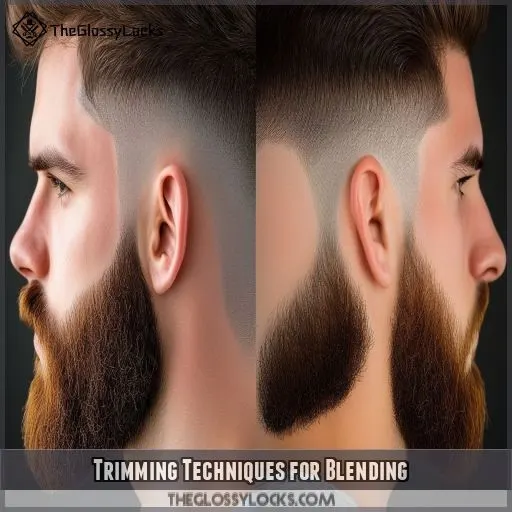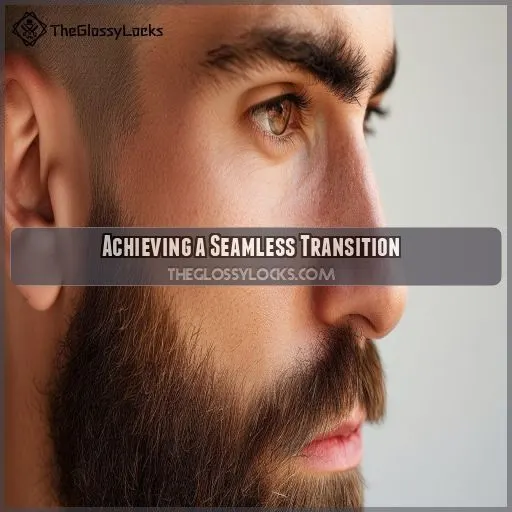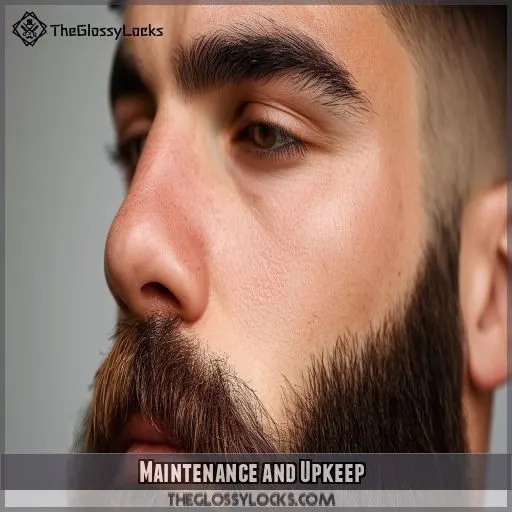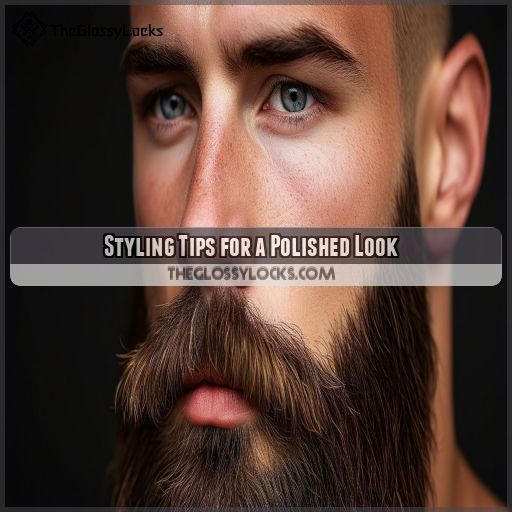This site is supported by our readers. We may earn a commission, at no cost to you, if you purchase through links.
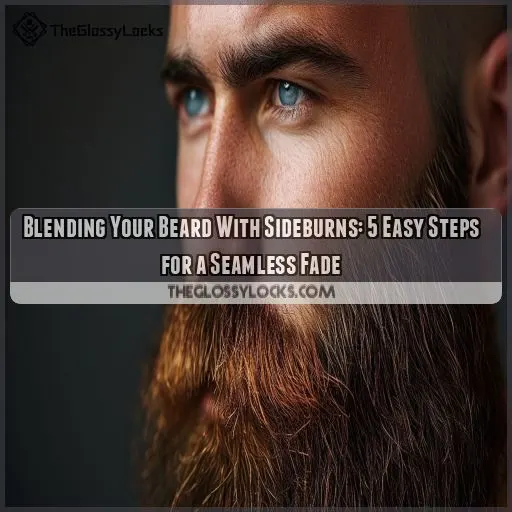 Blending your beard with your sideburns is all about creating a smooth connection.
Blending your beard with your sideburns is all about creating a smooth connection.
You want to avoid any harsh lines or disconnects, so work with the natural growth patterns of your hair.
Start by trimming your sideburns, gradually fading the length as you move down towards your beard.
Take your time and trim in small sections for a precise, controlled blend.
For a smooth taper, follow your natural hairline.
Use precision trimming scissors or a trimmer with a small guard for those minor adjustments.
You’re on the right track to mastering the art of blending your beard and sideburns.
Table Of Contents
- Key Takeaways
- Trimming Techniques for Blending
- Achieving a Seamless Transition
- Maintenance and Upkeep
- Styling Tips for a Polished Look
- Avoiding Common Mistakes
- Frequently Asked Questions (FAQs)
- How do I get my beard to fade into a sideburn?
- Does fading your sideburns make your beard look tighter?
- Are bald faded sideburns cool with a fade beard?
- How do I make my beard look longer?
- How do I blend my beard into my sideburns?
- Should I trim sideburns with a beard?
- Why is my beard not connected to my sideburns?
- How to blend beard into skin fade?
- How often should I trim my beard?
- How do I know which beard shape suits me?
- Whats the best way to apply beard oil?
- How can I stop my beard from itching?
- How do I get rid of beard dandruff?
- Conclusion
Key Takeaways
- It’s all about creating a smooth connection between your beard and sideburns, avoiding any harsh lines. Work with the natural growth patterns of your hair.
- Master the art of trimming, using the right tools and techniques, to achieve a gradual fade and a precise, controlled blend.
- Create a seamless transition by following your natural hairline and using precision trimming for a smooth, harmonious look.
- Maintain a well-groomed beard with a consistent routine, and style it with definition and a polished look using beard wax or balm.
Trimming Techniques for Blending
To blend your beard with your sideburns seamlessly, you’ll need to master some trimming techniques. Here’s a simple step-by-step guide:
- Use the Right Tools: Grab your barber scissors and a beard trimmer with guard settings. The guard settings are key to achieving a gradual fade.
- Start with the Sideburns: Begin your trim at the sideburns, working downwards. This helps create a smooth connection from your sideburns to your beard.
- Adjust the Guard Length: As you move downwards, adjust the guard length as needed to blend the hair smoothly. This creates a gradual fade effect.
- Work in Small Sections: For a precise and controlled trim, work in small, targeted sections. This helps you focus on blending the hair evenly and avoids over-trimming.
- Experiment with Guard Lengths: Don’t be afraid to play around with different guard lengths and angles. This is the key to finding the perfect fade for your beard and sideburns.
Achieving a Seamless Transition
Now that you’ve mastered the basic trimming techniques, it’s time to focus on creating a seamless blend between your beard and sideburns. Here’s how to achieve that smooth, harmonious look:
- Follow the Natural Hairline: Work with the natural flow of your hair. Avoid harsh, straight lines, and instead, create a gradual taper for a smooth change.
- Precision is Key: Use precision trimming scissors or a trimmer with a small guard size for minor adjustments. Trim little by little to avoid over-trimming and to make sure the blend looks natural.
- Go With the Growth: Work with the natural growth patterns of your hair. This will make the blending process easier and more effortless, resulting in a seamless fade.
- Take Your Time: Don’t rush the process. Blending your beard with your sideburns requires patience and a steady hand. Remember, you can always trim more, but you can’t add length back once it’s gone!
Maintenance and Upkeep
Maintaining a well-groomed beard requires a consistent routine and some extra care. Here are the key steps to keep your beard looking its best:
| Daily | Weekly |
|---|---|
| Apply beard oil once or twice | Wash beard 2-3 times |
| Brush beard twice | |
| Cleanse and exfoliate skin under beard |
Styling Tips for a Polished Look
Now that your beard is blended and maintained, it’s time to style it for a polished look. Here are some tips to achieve that sleek and defined appearance:
- Define the shape: Use your trimmer to create clean edges and define the outline of your beard. Play with different lengths to find the most flattering style for your face.
- Proportion and balance: Make sure your beard is in proportion to your sideburns. You don’t want one overpowering the other. Find that sweet spot where they complement each other.
- Tame and define: Beard wax or balm is your friend. Use these products to tame any flyaways and add definition to your style. Play around with different waxes and balms to find the hold and shine that suits your preference.
Avoiding Common Mistakes
Now that you’re a pro at blending your beard and sideburns, let’s talk about some common mistakes to avoid.
Consistency is key. Stick to a regular trimming and maintenance routine to avoid over-trimming and keep that seamless fade.
Blending is also important—you don’t want a disconnect between your beard and sideburns. Work with the natural growth patterns of your hair for a more natural blend.
Frequently Asked Questions (FAQs)
How do I get my beard to fade into a sideburn?
You want your beard to blend seamlessly with your sideburns, like two peas in a pod. Grab your beard trimmer with adjustable guards and start with the largest guard size, working your way up from the bottom of your ear.
Does fading your sideburns make your beard look tighter?
Yes, a beard fade can make your beard look tighter and more defined. It’s a great way to sharpen up your look and create a smooth shift from your sideburns to your beard.
Are bald faded sideburns cool with a fade beard?
Bald faded sideburns complement a fade beard. It’s a stylish, contemporary look that’s well-groomed and popular. A messy medium-length beard, for example, looks tamed and well-shaped with a mild bald fade.
How do I make my beard look longer?
To make your beard look longer, resist the urge to trim it. Let it grow, keep your hands off your face, and use a blow-dryer on a low setting to style and tame it.
How do I blend my beard into my sideburns?
You’ll want to create a gradual fade, starting from your sideburns and working downwards. Use adjustable guards on your trimmer to blend the hair smoothly. Work in small sections for a seamless blend.
Should I trim sideburns with a beard?
Ultimately, it’s your choice. Some people prefer the look of shorter sideburns, while others rock the longer, Rasputin-style sideburns. If you’re going for a clean, defined look, trim those sideburns.
Why is my beard not connected to my sideburns?
It’s likely due to bald spots or patches around your mouth and upper cheeks, where hair struggles to grow. You can stimulate dormant hair follicles, or hide gaps with a longer beard or dyes.
How to blend beard into skin fade?
To blend your beard with a skin fade, start by fading your neckline for a natural look. Use a guard one down from your overall beard length, then switch to a lower guard and gently flick the clipper along the line between hair and skin.
How often should I trim my beard?
How often you trim your beard depends on the length and style you’re going for. If you want to maintain a short, tight beard, you’ll need to trim every two weeks. For longer beards, you can leave it up to a month.
How do I know which beard shape suits me?
First, figure out your face shape: round, oval, square, rectangular, triangular, or heart-shaped. Then, choose a beard style that complements your face. For example, oval faces suit most beards, but not pointed ones.
Whats the best way to apply beard oil?
You’ll want to apply beard oil after a shower when your pores are open. Use 3-6 drops, rub it into your palms, then work it into your beard from the sides, down to your chin.
How can I stop my beard from itching?
Wash your beard regularly with a beard shampoo or wash to keep it clean and free of bacteria and dirt, which can cause itchiness. Use warm water and limit shower time to prevent dryness.
How do I get rid of beard dandruff?
Battling beardruff? It’s time to step up your beard care game. To get rid of beard dandruff, use a beard-specific shampoo and conditioner, followed by beard oil to moisturise and protect your skin.
Conclusion
Your beard and sideburns should blend seamlessly, creating a smooth, natural fade.
You’re now equipped with the knowledge to master this art. From trimming techniques to maintenance and styling tips, you can achieve a polished look that complements your unique facial hair growth.
With these easy steps, you’ll be blending your beard and sideburns like a pro, ensuring a smooth connection and avoiding any harsh lines.

